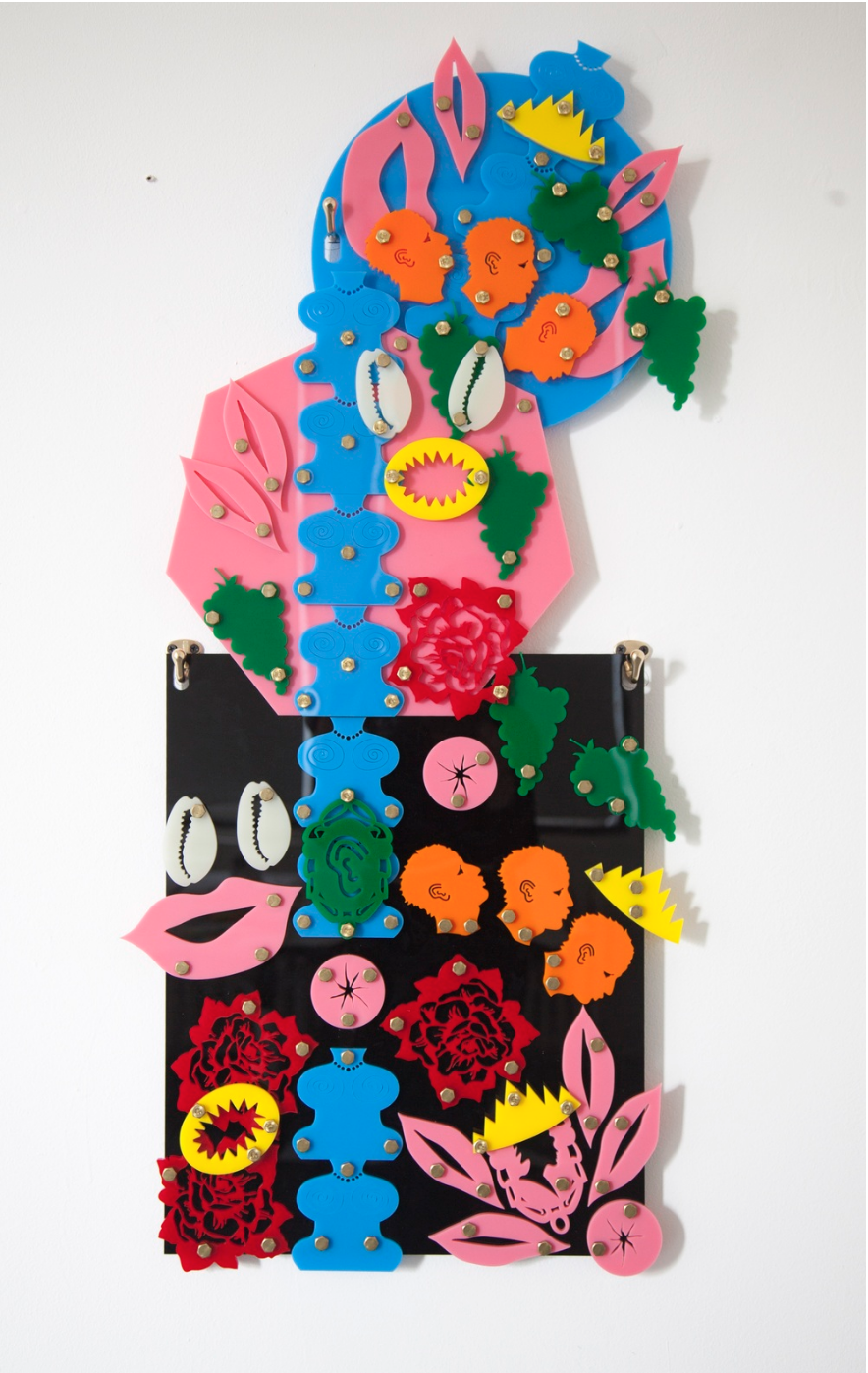Before his recent performance piece at Black Ball Projects, ETTD Editorial Assistant, Jongho Lee had a chance to sit down with artist Damien Davis and ask him a few questions about his exhibit “OBJECT/AFFECTION” which is also on view at Black Ball Projects until July 17th. The following is the conversation that took place.

Damien Davis, Installation view “OBJECT/AFFECTION,” (2016) at Black Ball Projects, Brooklyn. Image courtesy of gallery, 2016.
Jongho Lee: Tell me a bit about the blackamoor trope in western culture and how you came to reflect and interpret this idea through your work, specifically in”OBJECT/AFFECTION”.
Damien Davis: I started researching it for artist and NYU professor Lyle Ashton Harris, because he had been commissioned to do a project for the Black Portraitures II conference in Florence. The exhibition that he was a part of, “Resignifications” was all about re-examining the blackamoors as an aesthetic trope in art making. So for those who don’t know, the blackamoors are these decorative sculptures and objects that are prevalent throughout Italy that depict Africans, mostly northern Africans in various states of being or movement or servitude to white figures. The thing that a lot of people don’t really understand is that the blackamoor sculptures were being created during the same time [of many well-know] Italian master sculptures. So it was very common to see something like Michelangelo’s David traditionally presented along with blackamoor sculptures; you would see these other smaller sculptures of black people who were made with the sole purpose of functioning in support of other larger, more important works. So this idea of the slave or the servant gets played out in the way these objects are produced, considered and processed was something that Lyle’s exhibition Resignificaitons was trying to move through.
For me, how I came to this work was one: by doing that research in support of him, and then being asked to do a performance piece by a friend, Jeffery Burdian in May, 2014. I’d been thinking about these sculptures and objects, and I had been trying to figure out a way to incorporate them into my practice, which has been really concerned with the computer, and vectors, and lines, and making shapes and coming up with a discreet iconography that I can claim as my own. In an attempt to figure out how to come up with a performance piece for this night, I created all these little shapes inspired by various things related to the blackamoor such as exaggerated lips, or various shells, candelabrum, lanterns, chains, teeth, things like that. Each object got cut out in Plexiglass on the laser cutter. While I was cutting these laser cut pieces, it hit me that these are beautiful objects in their own right, and that they could become something else, they could become collages, and that’s what led to this other body of work, just allowing these pieces of Plexiglass to almost function as if they are pieces of paper, but then going a step further to really think about how they’re going to be connected and presented, and really think back to the original source, which is the blackamoors and just thinking about these objects in service to the more important work.
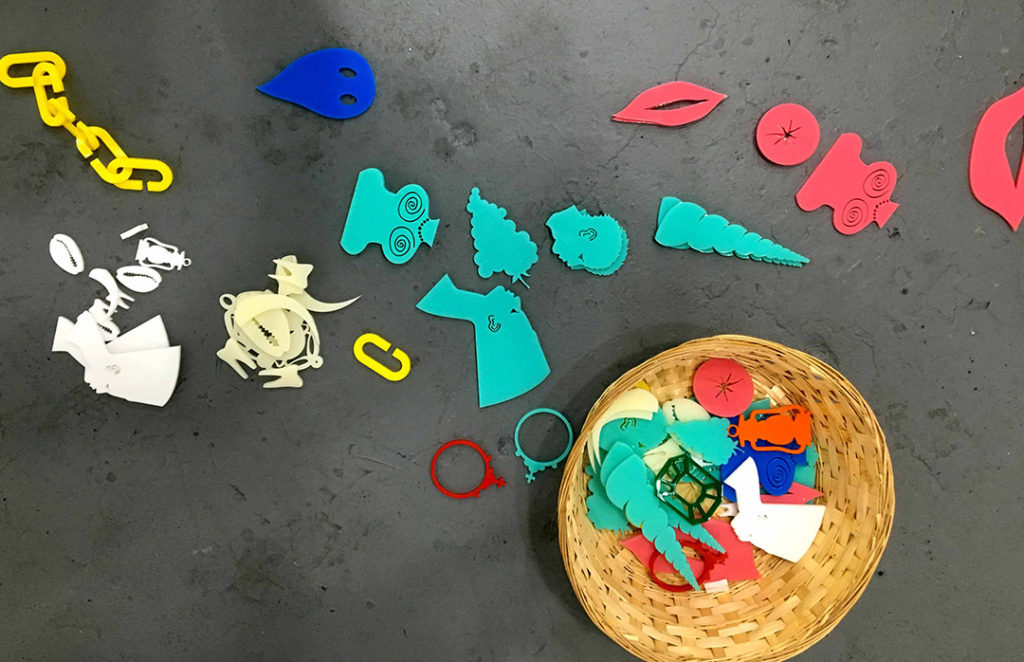
Damien Davis, objects used for performance at Black Ball Projects, Brooklyn, 2016. Photograph by Jongho Lee, 2016
JL: You mentioned the word collage, do you consider and treat them more like as if they were cut out of paper, more than sculptures, or objects?
DD: A lot of the work that I do for me, is really about trying to figure out this space in between where it’s not a drawing, and it’s not a sculpture, and it’s not a painting, and it’s not a collage, but it’s somehow all those things at the same time, So just through the process of making these things, because they exist on the computer, as just lines and vectors, in that early stage of the process, I really consider firmly invested in the tradition of drawing and painting, line making, and then there’s this other thing that happens compositionally where for me it is very much about painting, collage, and abstraction. And then, there’s this third back-end with the construction where it’s really about considering the materials as their own discrete objects that have their own specificity and just owning up to that, and letting the material be what it is, and letting the work to be sculptural in that sense: that it’s just honest about what it is.
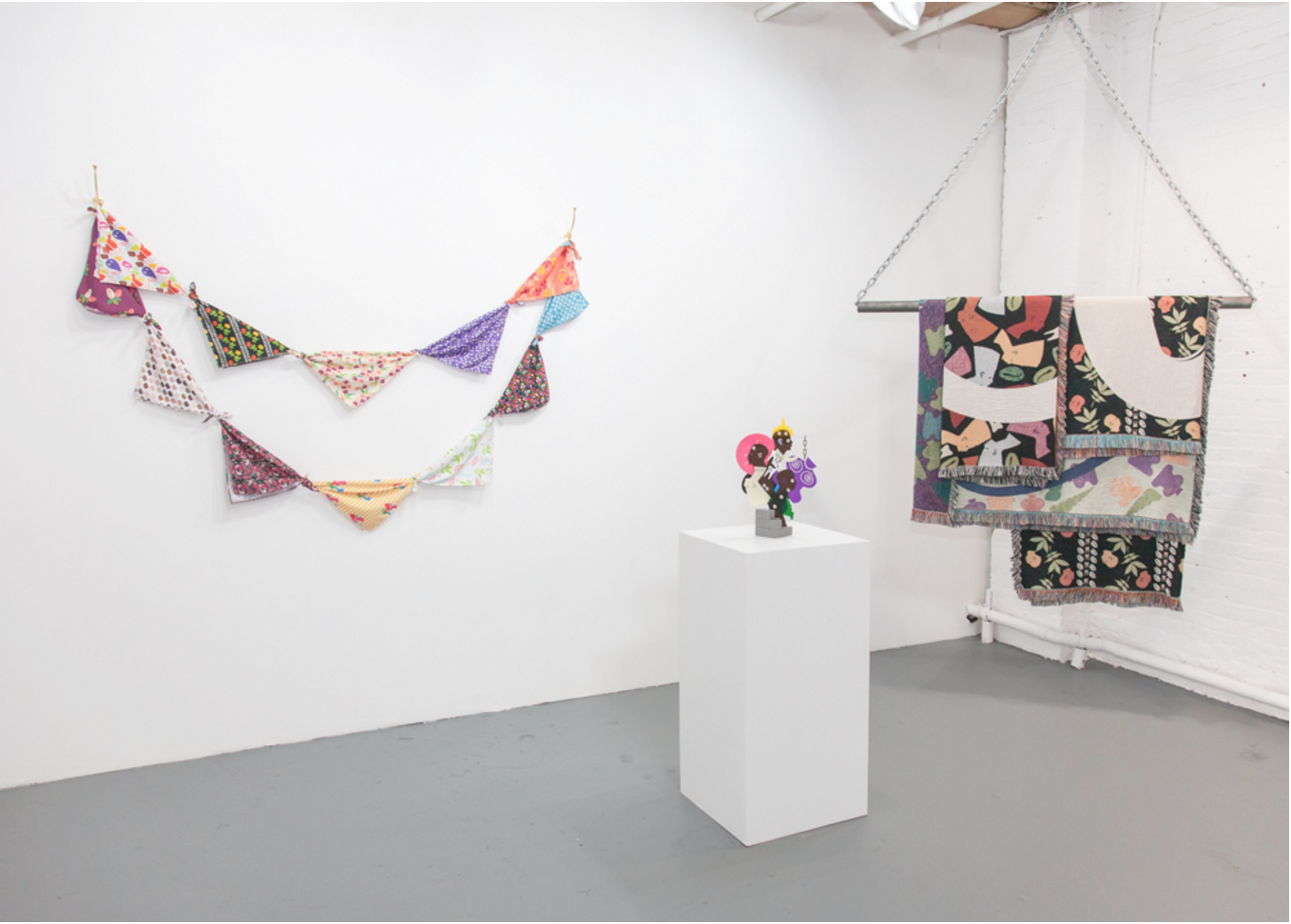
Damien Davis, “OBJECT/AFFECTION” (2016), Partial installation view, Left to right: “Semaphore” (2016), “Connections (Totem #5),” (2016) “Gesture,” (2016) Photo courtesy of Black Ball Projects, Brooklyn, 2016
JL: I know some of the art in this body of work, have been shown before, but I am curious about your shift in material with Gesture (2016) and Semaphore (2016), both textiles. It’s such a departure from the Plexiglass. can you talk about that process?
DD: You know, there’s something about producing these objects in a way where, it’s about the computer, it’s about the machine, the end product, there’s points of access where you can begin to talk about these things, but to me, they are not ultimately about technology or the computer the same way a painting is not about a paintbrush. It was about figuring out all these other strategies to take the same iconography and export it through other digital means of production, So one of them was a digital loom, where you send the file out and the computer determines, based on the hex codes, or the color or whatever, how to weave these threads together to produce the piece that you see.
The other one, these textile patterns, the one in the show is actually an off shoot from another piece that I created for a show out in Minnesota, for a curator Matthew Schum. He’s doing this piece all about the midwest and colonialism so he asked me to make a traditional quilt for him. Because my practice involves researching objects and learning how to incorporate my iconography in the production of these objects, what i did was i researched all these 18th and 19th century textile patterns that were emblematic or representative of the time period that he’s trying to dig into with the work, and then use the same iconography from this other project to create this. So what’s hopefully happening is from a distance, they are seemingly casual textile patterns that you could buy at a store. And then, upon closer examination, you kind of start to see the actual individual icons begin to kind of come out, and you’re able to dig into what those are and what they mean. So this was, essentially taking these patterns and creating a piece that can kind of reference some of the other things that are going on, the teeth, the smiley face, the hardware, things like that. But its nice, it’s a different way of working for me, because it’s… with this stuff, the Plexiglass, I’m there from start to finish. So to have something, send it out, and get it back is disorienting in all these other ways that I’m still trying to figure out. The textile piece is very new, so I’m interested to see what people have to say.
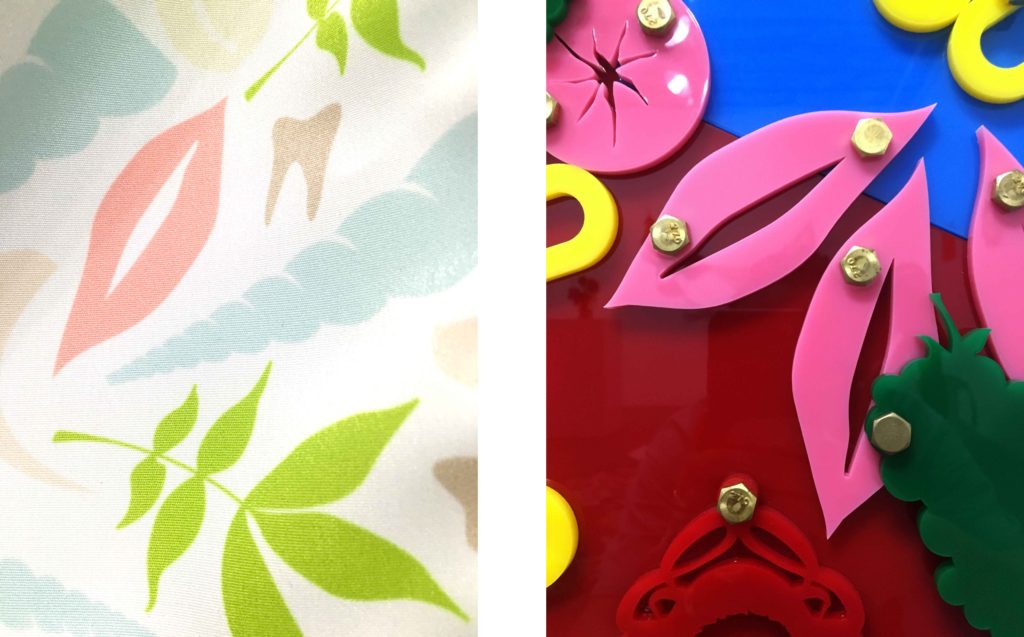
Damien Davis, Left: Detail shot of “Semaphore,” (2016) Textile and Brass. Right: Detail shot of “Scatter Plot (Blackamoors Collage #13),” (2014) Plexiglass and Brass. Photographs by Jongho Lee, Brooklyn, 2016.
JL: In both ways of working, deconstructing images and icons that are significant to your own black historical culture and self-identity is crucial to your work, and you do all the research based on what you said about Michelangelo and how these sculptures would be produced and even exhibited in a demeaning manner. What remains are these Plexiglass collages or these textiles that are generated through technology. On the flip side, is it difficult, emotionally and or mentally to make works that are so autobiographical to not only your life, but that deals with a view of your culture that you didn’t have a say on?
DD: You’re the first person to actually ever ask me that. Which is crazy.
JL: Well when I was processing and thinking about your show, and I thought back to my studio visit with Erika Ranee, who was involved in the heart of this movement back in the 90’s with Lyle Ashton Harris, who you mentioned, and Ellen Gallagher, and all these other artists that were making works based on their identity, and specifically their black identity, and she mentioned that when she departed from making those figurative, identity based works, into abstraction, how so tiring it was to make such works back then. I wanted to completely dive into that conversation, since it’s something I’ve been wondering about.
DD: I think about Erika Ranee’s earlier works a lot because the stuff that I’m doing. My hope is picking up where that identity politic-focused work in the 90’s left off. I don’t think that identity politics are coming back, I think that people are looking back at that work now that there’s some distance, and they’re figuring out a way to reintroduce those conversations that were maybe a little bit more clumsy, back into the conversation.
People are much more willing and inclined and prepared to have this conversation about intersectionality in the way we talk about diversity. These things don’t exist in silos anymore. You can’t talk about my experience as a gay black male as if those are three separate things, you know?
JL: Right.
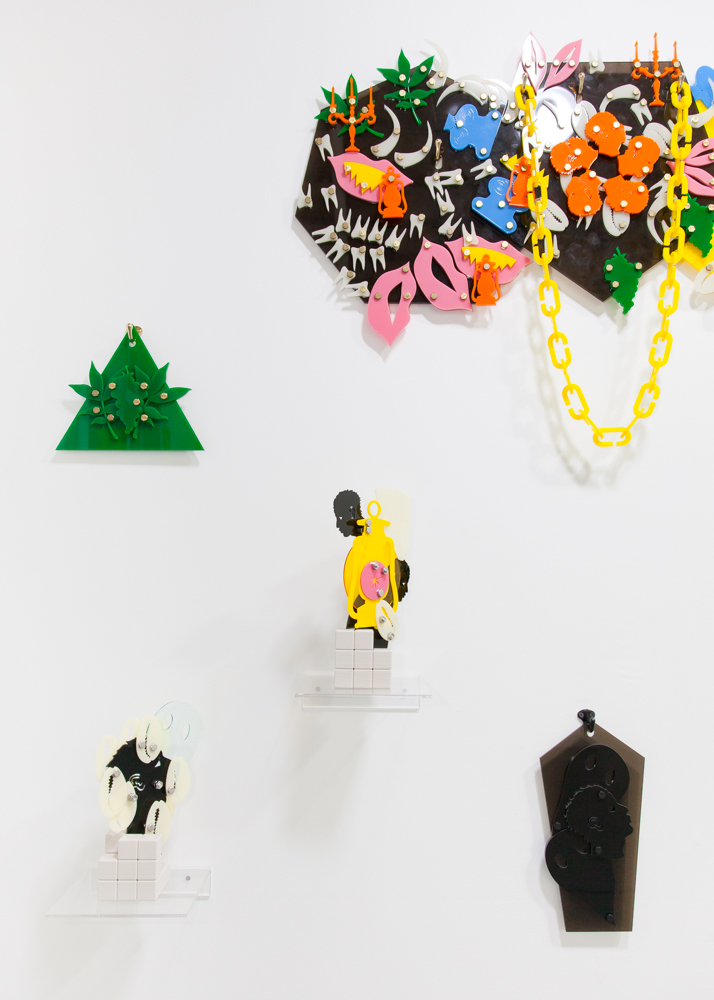
Damien Davis,”OBJECT/AFFECTION,” (2016), Partial installation view. Photograph by Black Ball Projects, Brooklyn, 2016.
DD: So for me, this work is really about kind of trying to pick up where that left off and say that in a way, ‘no, this conversation isn’t over’ you know, there’s still all these codes, and this visual language that we are deeply entrenched in that we haven’t divorced ourselves from that we still actively…
JL: Ignore?
DD: Ignore, code, we decode, constantly. And it’s something that is so pervasive that we don’t even recognize that we’re doing it. The hope is you approach something like this, and maybe you’re taken in because it seems pretty, and you actually start to look at these individual shapes, and you think about what they mean when you put them together (putting together a head and a spiral from his set of objects), ‘what’s going on?’
I think a lot about the 90s and i think that there’s a way to reclaim identity and import into the work, and have it feel… i don’t want to use the word universal or identifiable because it makes the assumption that there is some neutrality or there is some default in the viewer. And i think for me, a big part of my work is about acknowledging that there is no default viewer. Someone with my personal history or a personal history that’s close to mine is going to read these images, these objects in a completely different way from someone who doesn’t have that experience of seeing exaggerated lips next to loose teeth. They’re gonna have this other kind of visceral response to these images in a different way, or someone might interpret the teeth as anxiety, or something other that teeth tend to traditionally get associated with.
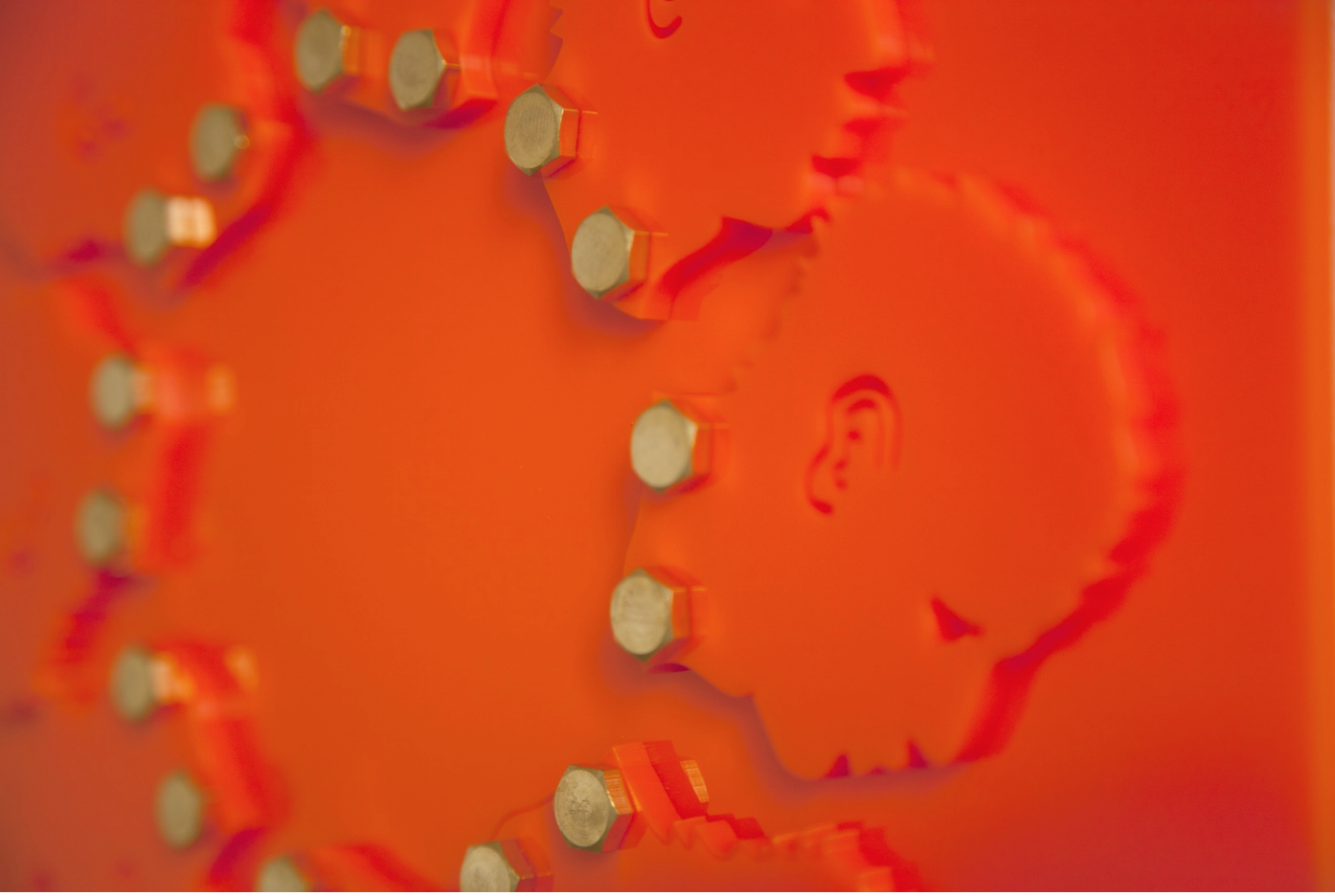
Damien Davis, “Spiral of Sardinia (Blackamoors Collage #5),” (2014). Image courtesy of the artist, 2016
JL: Departing from that heavier topic, how do these objects/icon that you’re dealing with tie into the theme of affection, which is clear from even the title of the show OBJECT/AFFECTION?
DD: The OBJECT/AFFECTION title of the show really came from my having trouble grappling with the iconography that the work is dealing with, but also my personal relationship to these objects that I was making… I should maybe step back for a second. I think what was happening was that I having a really hard time reconciling the fact that I was making all this work and doing this show that was.. Quite possibly just a bunch of pretty objects.
Everything here has a story to it, and its about my personal history, my personal narrative as an artist. Because the work is about investigating these decorative objects as a trope, the decorative nature of the work is important from a conceptual level, but at the same time I don’t want that to be the only thing that gets considered, the only thing that people see when they read the work, that they are just pretty things. As a way of trying to push back on that, the challenge then was how can I pull out these things that I’m dealing when I produce the work, which is about having anxiety, dealing with depression, feeling ugly all the time, and how do I put that back in the front of the work. And that’s where the sale agreement came from.
JL: That was my next question. I was taken by the elegance of some of the statements on the agreement and wanted to ask where the whole idea stemmed from.
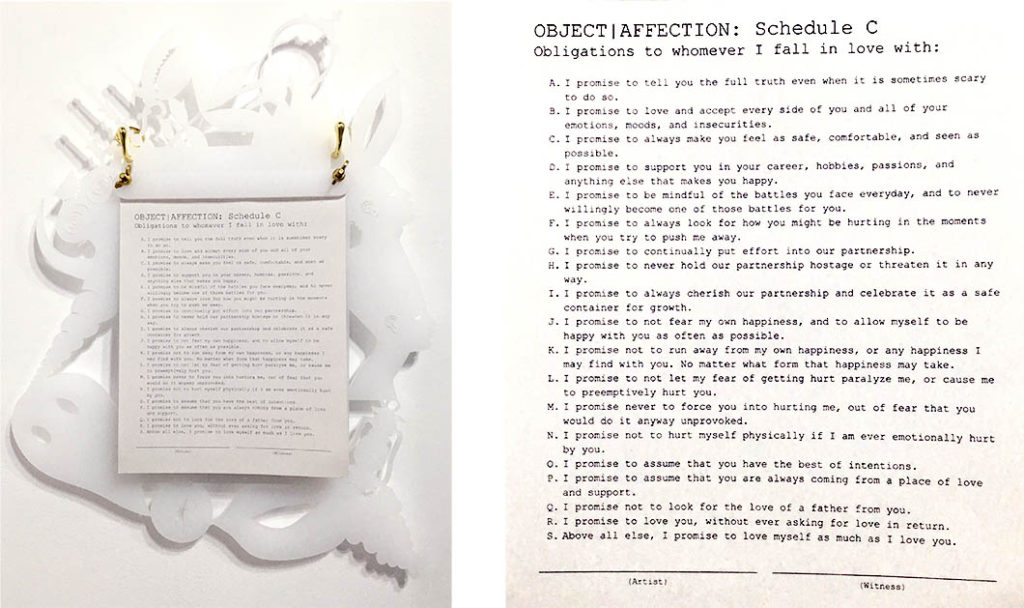
Damien Davis, Exhibition Sale Agreement, Photography by Jongho Lee, Brooklyn, 2016
DD: This past spring, I was a fellow in the art and law program here in New York ran by Sergio Sarmiento. Once a week, we would meet for three hours and talk about the law as artists. We read legal cases, about legal theory, and the thing that Sergio always said was figuring how to be artists that think like lawyers, or how to be artists that can use the law as a medium for making work. So I came up with this sale agreement, which is riffing off of Seth Siegelaub’s (curator, art dealer) sale agreement, where ideally, the artist would reach an agreement with a potential buyer and they would say ‘these are the rights that I am going to retain when I sell the works to you.’ Right for percentage of resale, right to be consulted if the work gets damaged, things like that. What I’m doing with this sale agreement is first, acknowledging that it’s my first exhibition and the work has a certain provenance that none of the other work is going to have. And that the pricing of the work is rooted in this deeply flawed, fucked up, speculative art market, where it says I’m putting a number value on this work, but its not.. I mean how do we even begin to talk about how we create value around art? Especially if were going to talk about a lot of the issues that the actual work is dealing with, and in my mind one of the big themes with the Plexiglass work is about dealing with this issue of currency. Monetary currency, people as currency, various forms of currency, sexual currency, emotional currency, and trying to wade through those issues. By creating a sale agreement where there’s a space opened up to have an honest conversation about what the work is worth, and other ways beyond money to make this exchange, that was important to me.
Essentially what happens if someone were to purchase a work, “purchase” being in quotation marks is I would waive all my legal rights to the work. Any current or potential future rights afforded to me at state, federal, and international level, I’m saying I’m waiving all of those. You can do whatever you will with the piece after it is signed over to you. You can sell it, and even if it somehow becomes worth a lot of money you can still sell it- I don’t have any rights to that. You can produce thousands of copies of that piece, you can destroy it, whatever you want with it. In exchange for that, the least desired piece, the piece that doesn’t get sold, which wont happen until years after this show ends, that piece gets rendered forever unsellable. It’s a way of trying to protect and reclaim the most unwanted piece in the show. That work will forever have to get presented with the sale agreement with the contract on the clipboard. So one of these pieces will at one point in time, get forever bound to that clipboard on the wall. And then there’s other things in that sale agreement that are dealing with really personal issue: my father’s death, and my brother’s death. A percentage of the money made from this show goes towards my brother’s memorial scholarship fund, which is for students of African American descent who are majoring in engineering. I think it’s funny, because I considered my brother and I diametrically opposite of each other, and now I’m looking at my works and thinking ‘Oh shit, I’m kind of an engineer now’ haha. So it’s about dealing with love and loss, and there’s some romantic stuff in there that maybe we’ll save for another day, another conversation.
JL: Thank you for opening up, and talking about yourself as an artist and the work in the exhibition.
Damien Davis is an artist that lives and works in New York City. His first solo exhibition, “OBJECT/AFFECTION” is on view at Black Ball Projects in Brooklyn, New York until July 17th.

